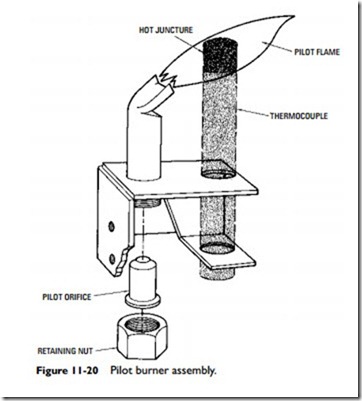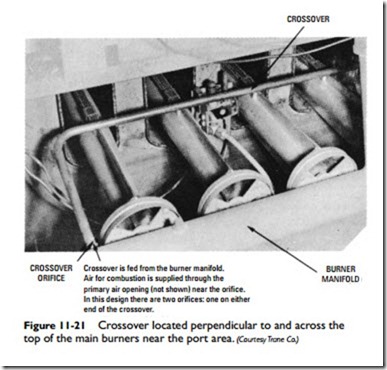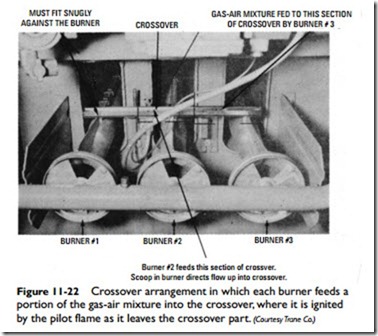Gas Pilot Assembly
The gas pilot assembly in a standing-pilot gas furnace consists of a pilot burner and a pilot safety device (Figure 11-20). The most commonly used pilot safety is the thermocouple lead operating in conjunction with a companion valve or switch. The thermocouple itself is actually a miniature generator that converts heat (from the pilot flame) into a small electrical current. The upper half of the thermocouple is located in the pilot flame. As long as the pilot flame is operating, an electrical circuit is maintained between the pilot burner and the gas valve. If the pilot flame goes out, the circuit between the thermocouple and the gas valve is broken. As a result,
the gas valve closes and shuts off the gas flow to the pilot burner. Other pilot safety devices used with gas-fired furnaces are described in Chapter 5 of Volume 2, “Gas and Oil Controls.”
Smaller gas furnaces, such as those used in RV furnaces, mobile homes, and swimming pool heaters, may use a millivolt system instead of a thermocouple. The pilot heats the millivolt device until it generates enough electricity to operate the main gas valve. There is no need to incorporate a 24-volt transformer, because with a millivolt system the burner will not operate if the pilot is not lit.
Many gas furnaces contain several individual heat exchanger sec- tions with a gas burner inserted in each section. In this arrangement, all burners must fire almost simultaneously, or there will be danger of unburned gas flowing into the combustion chamber. Simultaneous ignition can be provided by installing a crossover burner across the top of the main burners near the port area. Figures 11-21 and 11-22 show the types of crossovers in Trane gas-fired furnaces.
High-efficiency gas furnaces do not have a continuously burning pilot light. In these furnaces, an electronic pilot assembly takes the place of the standing-pilot and thermocouple. These pilot assemblies contain a pilot, a spark ignition, and a flame sensor (Figure 11-23).


